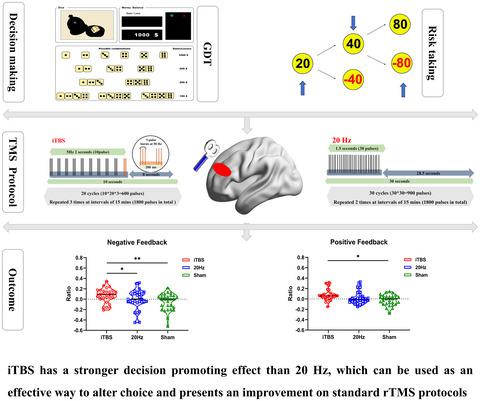当前位置:
X-MOL 学术
›
J. Neurosci. Res.
›
论文详情
Our official English website, www.x-mol.net, welcomes your feedback! (Note: you will need to create a separate account there.)
Better modulation for risk decision‐making after optimized magnetic stimulation
Journal of Neuroscience Research ( IF 4.2 ) Pub Date : 2021-01-01 , DOI: 10.1002/jnr.24772 Lu Wang 1, 2, 3 , Xingqi Wu 1, 2, 3 , Gong-Jun Ji 1, 2, 3, 4 , Guixian Xiao 1, 2, 3 , Feifei Xu 2, 3, 4 , Yibing Yan 1, 2, 3 , Yang Wu 2, 3, 4 , Chunhua Xi 2, 5 , Xingui Chen 1, 2, 3 , Kai Wang 1, 2, 3, 4
Journal of Neuroscience Research ( IF 4.2 ) Pub Date : 2021-01-01 , DOI: 10.1002/jnr.24772 Lu Wang 1, 2, 3 , Xingqi Wu 1, 2, 3 , Gong-Jun Ji 1, 2, 3, 4 , Guixian Xiao 1, 2, 3 , Feifei Xu 2, 3, 4 , Yibing Yan 1, 2, 3 , Yang Wu 2, 3, 4 , Chunhua Xi 2, 5 , Xingui Chen 1, 2, 3 , Kai Wang 1, 2, 3, 4
Affiliation

|
Traditional repetitive transcranial magnetic stimulation can only produce a significant but weak effect on the cortex while theta burst stimulation (TBS), a patterned accelerated form of stimulation, can produce a stronger poststimulation effect, which may improve decision‐making abilities. We designed a comparative assessment of the effect of intermittent TBS (iTBS), 20 Hz, in two risk decision‐making tasks on healthy controls. Participants were randomized and assigned to the iTBS (n = 29), 20 Hz (n = 29), or sham (n = 29) groups. The effects of the different methods of left dorsolateral prefrontal cortex stimulation on risk decision‐making functions were compared based on subjects’ performance in the Game of Dice Task (GDT) and Risky Gains Task (RGT). The main indicators were positive and negative feedback utilization rates of GDT and RGT. Both iTBS and 20 Hz stimulation resulted in significant improvements upon negative feedback in the GDT, with increases in safe options and reductions in risky options; iTBS stimulation increased subjects’ use of positive feedback in the GDT and RGT (all p < 0.05). Furthermore, the iTBS group had a stronger feedback risk reduction effect than the 20 Hz or sham group following RGT negative feedback (p < 0.05). Individuals would integrate positive and negative information more efficiently, leading to them making rational choices after excitatory transcranial magnetic stimulation. Moreover, iTBS has a stronger risk reduction effect following negative feedback than the 20Hz stimulation did. In summary, iTBS might have clinical value in decision promotion.
中文翻译:

优化磁刺激后更好地调节风险决策
传统的重复经颅磁刺激只能对皮层产生显着但微弱的作用,而θ脉冲刺激(TBS)是一种模式化的加速刺激形式,可以产生更强的后刺激效应,这可能会提高决策能力。我们设计了对间歇性 TBS (iTBS)(20 Hz)在健康对照的两项风险决策任务中的影响的比较评估。参与者被随机分配到 iTBS ( n = 29)、20 Hz ( n = 29) 或假 ( n = 29) 组。根据受试者在骰子游戏任务 (GDT) 和风险收益任务 (RGT) 中的表现,比较了不同的左背外侧前额叶皮层刺激方法对风险决策功能的影响。主要指标为GDT和RGT的正负反馈利用率。iTBS 和 20 Hz 刺激都显着改善了 GDT 中的负反馈,增加了安全选项,减少了风险选项;iTBS 刺激增加了受试者在 GDT 和 RGT 中对正反馈的使用(所有p < 0.05)。此外,在 RGT 负反馈后,iTBS 组比 20 Hz 或假手术组具有更强的反馈风险降低效果(p < 0.05)。个体会更有效地整合正负信息,导致他们在兴奋性经颅磁刺激后做出理性选择。此外,与 20Hz 刺激相比,iTBS 在负反馈后具有更强的风险降低效果。总之,iTBS 在决策促进方面可能具有临床价值。
更新日期:2021-01-29
中文翻译:

优化磁刺激后更好地调节风险决策
传统的重复经颅磁刺激只能对皮层产生显着但微弱的作用,而θ脉冲刺激(TBS)是一种模式化的加速刺激形式,可以产生更强的后刺激效应,这可能会提高决策能力。我们设计了对间歇性 TBS (iTBS)(20 Hz)在健康对照的两项风险决策任务中的影响的比较评估。参与者被随机分配到 iTBS ( n = 29)、20 Hz ( n = 29) 或假 ( n = 29) 组。根据受试者在骰子游戏任务 (GDT) 和风险收益任务 (RGT) 中的表现,比较了不同的左背外侧前额叶皮层刺激方法对风险决策功能的影响。主要指标为GDT和RGT的正负反馈利用率。iTBS 和 20 Hz 刺激都显着改善了 GDT 中的负反馈,增加了安全选项,减少了风险选项;iTBS 刺激增加了受试者在 GDT 和 RGT 中对正反馈的使用(所有p < 0.05)。此外,在 RGT 负反馈后,iTBS 组比 20 Hz 或假手术组具有更强的反馈风险降低效果(p < 0.05)。个体会更有效地整合正负信息,导致他们在兴奋性经颅磁刺激后做出理性选择。此外,与 20Hz 刺激相比,iTBS 在负反馈后具有更强的风险降低效果。总之,iTBS 在决策促进方面可能具有临床价值。



























 京公网安备 11010802027423号
京公网安备 11010802027423号